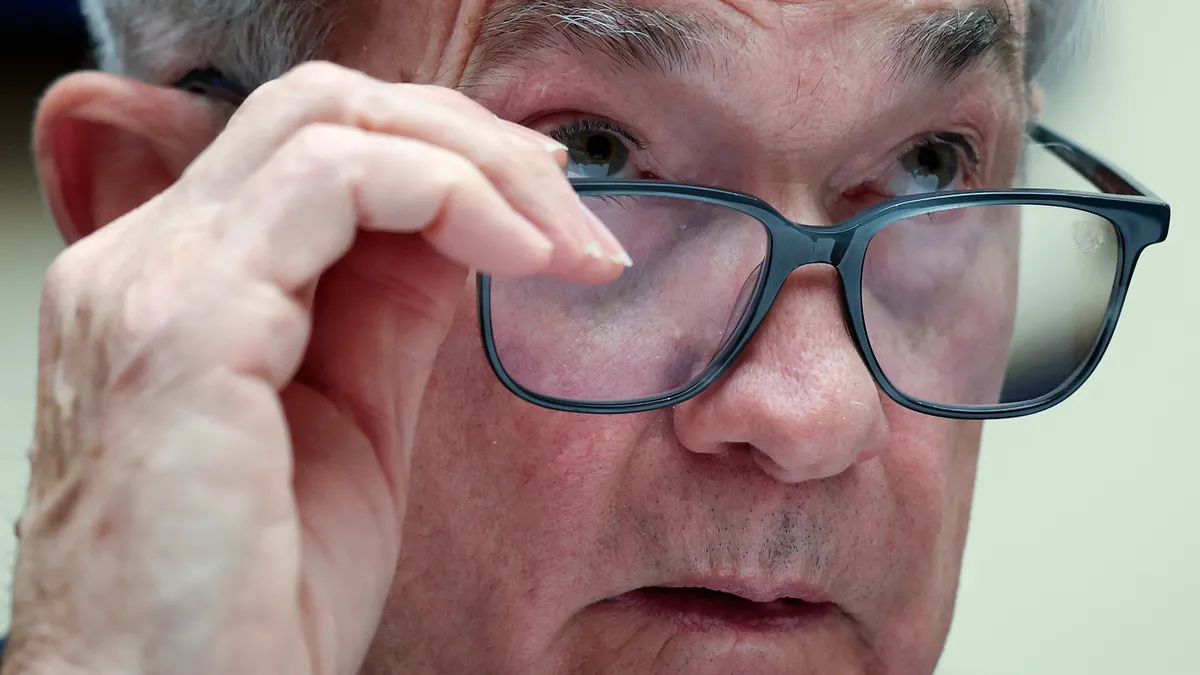Dive Brief:
- The Federal Reserve raised the federal funds rate Wednesday by 0.5 percentage point, downshifting after a streak of four consecutive 0.75 percentage point increases while raising its estimate for rate hikes next year.
- Pressing on with the most aggressive policy tightening since the 1980s, the central bank pushed up the benchmark interest rate to a range between 4.25% and 4.5%. Most Fed officials forecast the central bank will increase rates by the end of next year to about 5.1%. In September they projected raising the main rate in 2023 to about 4.6%.
- “It’s our judgment today that we’re not at a sufficiently restrictive policy stance yet, which is why we say that we would expect that ongoing hikes will be appropriate,” Fed Chair Jerome Powell said at a press conference.
Dive Insight:
Fed officials hold a gloomier view of economic growth, unemployment and inflation than in September, when they last released forecasts. They see gross domestic product expanding just 0.5% next year and 1.6% in 2024 compared with their September estimates of 1.2% and 1.7% growth, respectively.
Also, they increased their estimate for the unemployment rate during both 2023 and 2024 to 4.6% from 4.4% in September. The unemployment rate in November was 3.7%.
The central bank’s preferred gauge of inflation — the core personal consumption expenditures (PCE) price index excluding volatile food and energy prices — will likely rise 3.5% next year and 2.5% in 2024, according to the officials’ median projections, compared with their estimates in September of 3.1% and 2.3%, respectively. Core PCE rose 5% during the 12 months through October, far above the Fed’s 2% inflation target.
Policymakers, after underestimating the threat of price pressures in 2021, have begun to curb the highest inflation in nearly four decades with seven consecutive rate hikes this year totaling 4.25 percentage points.
Powell said Wednesday that more rate increases are in the cards for 2023.
“We have more work to do,” Powell said. “Reducing inflation is likely to require a sustained period of below trend growth and some softening of labor market conditions.”
“The historical record cautions strongly against prematurely loosening policy,” he said. “We will stay the course until the job is done.”
Powell has acknowledged the risk that excessive tightening may tip the economy into recession, hurting businesses and pushing up unemployment.
At the same time, he has repeatedly underscored the difficulty of reversing high, deeply rooted inflation, and said that he leans toward a hard line approach to monetary policy even at the risk of undercutting demand.
“There will be some softening in labor market conditions, and I wish there were a completely painless way to restore price stability,” Powell said. “There isn’t, and this is the best we can do.”
Data in recent weeks indicates that the central bank has made gains in easing price pressures.
The Consumer Price Index (CPI) in November rose at the slowest pace in 15 months, increasing 7.1% from a year ago compared with 7.7% in October, the Labor Department said Tuesday. On a monthly basis, the CPI rose 0.1% last month compared with 0.4% in October.
The Producer Price Index, a measure of what suppliers charge, rose 7.4% in November from a year earlier after increasing 8.1% in October and 11.7% in March, according to the Labor Department.
Also, consumer expectations for inflation fell last month for the one- and three-year time horizons, the New York Fed said on Monday. Consumers expect inflation to slow to 5.2% in 12 months and 3% in three years, or 0.7 percentage point and 0.1 percentage point less than forecast in October.
“The inflation data received so far in October and November show a welcome reduction in the monthly pace of price increases,” Powell said. “But it will take substantially more evidence to give confidence that inflation is on a sustained downward path.”
Powell flagged the inflationary threat from an unusually tight job market, with steadily increasing wage gains and the number of people looking for work far less than the number of job openings.
“The labor market remains extremely tight, with the unemployment rate near a 50-year low, job vacancies still very high and wage growth elevated,” Powell said. The job market “continues to be out of balance, with demand substantially exceeding the supply of available workers.”
The labor market imbalance is especially inflationary in the non-housing services sector, Powell said. “We want strong wage increases — we just want them to be at a level that’s consistent with 2% inflation.”
Powell dismissed any suggestion that the central bank will soon reverse course and begin reducing borrowing costs. “I wouldn’t see us considering rate cuts until the [Federal Open Market Committee] is confident that inflation is moving down to 2% in a sustained way.”












